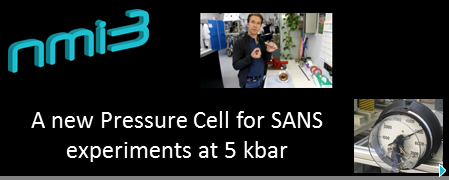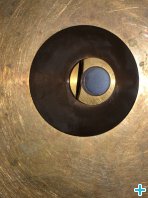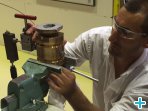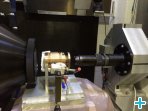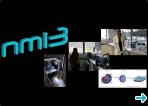A new pressure cell for SANS experiments up to 500MPa
In a new video you can learn of a new pressure cell that makes it easier to conduct SANS experiments at 500 MPa.
Inês Crespo, 12/02/2016
Until 2012, when NMI3-II started, it was really difficult, if not impossible, to conduct experiments at more than 240 MPa of pressure on SANS instruments. However certain samples, namely biological samples, reveal more information about their structure and dynamics when they are investigated at different pressures. Examples of research applications with pressure cells are degenerative diseases like Alzheimer, sterilisation of food and drinks, cleaning sea water, etc. It was thus the goal of a task part of the NMI3 Joint Research Activity on Soft and Bio materials to develop a ‘simple’ pressure cell that could handle pressures as high as 500 MPa in Small Angle Neutron Scattering (SANS) experiments.
Such a high-pressure cell would have to be very transparent to neutrons because these kinds of samples are very small in size, sometimes very expensive, and when the neutron background produced by the cell is too high, it is not possible to measure the sample.
Two activities were then carried out in parallel at the Forschungs-Neutronenquelle Heinz Maier-Leibnitz (FRM II) in Germany and at the Institut Laue-Langevin (ILL) in France, using different solutions to address the problem. I have been to ILL where Eddy Lelièvre-Berna, who is Head of Services for Advanced Neutron Environment at ILL, explained me that his team used sapphire windows for the pressure cell. These windows represented a challenge because they can easily break. They have worked very close to scientists at the Laboratoire Léon Brillouin (LLB) in France. They prepared a conceptual design and presented it to their JRA colleagues to discuss the weak points that needed improvement, and subsequently modified the design to maximize the chances of success. Following the discussions, they built a prototype and tested it first in the lab and then in a neutron beam at the D11 instrument at ILL with LLB colleagues.
As Eddy tells us in the video, the transparency of the cell is crucial for users, achieving 84% transmission at 6 Å. Scientists from LLB already used the cell to conduct experiments and were impressed with how little background noise there was. In the video, Eddy tells about the pressure cell, the pieces that constitute it, and how to assemble it before a neutron experiment.
The prototype built at ILL serves as basis to build three different variations, according to the requirements of different experiments and instruments. These are:
- 50 MPa for Spin-Echo providing Ø30 mm incident beam access
- 300 MPa for SANS providing Ø10 mm incident beam access (2 copies)
- 500 MPa for SANS (the one explained here)
The team hopes that these pressure cells will be widely used around the globe by anyone who needs to analyse samples at high pressure.
Scientists, engineers and technicians who participated in this project were Burkhard Annighöfer, David Bowyer, Annie Brulet, Alexandre Colas-De-La-Noue, Sophie Combet-Jeancenel, Bela Farago, Julien Gonthier, Peter Lindner, James Maurice, Claude Payre, Ralf Schweins.
NMI3 thanks Eddy Lelièvre-Berna for reviewing this article.
Recent news from this JRA
New video: Step-by-step to a neutron experiment with bio matter
Watch our new video where scientists explain us the steps taken before conducting a neutron experiment on biological samples. Read more.
Big progress in the production of model biological membranes
An NMI3 JRA has made significant progress in the production of biological membranes that can be used for structural and dynamic characterisations. Read more.
Advanced Neutron Tools for Soft and Bio Materials JRA – latest achievements
It is time for a summary of the achievements by this JRA, which aims to provide a wider range of experimental tools to make the best use of neutron scattering for soft and bio-materials. Read more.
